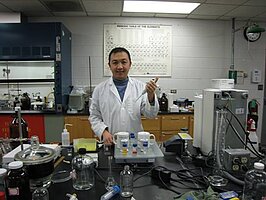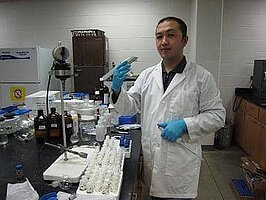Rapid and Sensitive Determination of Bacteria in Water Using Nanoparticles

Yuhui Jin (PhD Student)
Department of Chemistry University of North Dakota
Grand Forks, ND 58203
Degrees: 2001- B.S. Jilin University (PRC)-Chemistry; 2004- M.E. Jilin University (PRC)-Chemical engineering.
Email: yuhui.jin@und.nodak.edu
Fellow: Yuhui Jin, Department of Chemistry, UND
Advisor: Julia Xiaojun Zhao, Assistant Professor of Chemistry, UND
Matching Support: Department of Chemistry, UND
Degree Progress: Ph.D. expected in May 2009.
Rapid and Sensitive Determination of Bacteria in Water Using Nanoparticles
Project Background:
Bacteria can grow or re-grow in distribution systems of drinking water. In fact, potable water is a major source of some bacteria colonization. Given the low infectious dose of pathogenic bacteria, the presence of even a single bacterium in potable water may pose a serious health risk. Therefore, sensitive and rapid detection of bacteria in water is critical.
However, the current definitive method for the detection of bacteria is the culture of the organism, which requires about 24 hours for bacterial growth. The method is too slow to meet the public need. The PCR-based method can detect bacteria within 6 hours; but the method requires pre-enrichment of the target bacteria. The proposed method will be able to specifically identify target pathogenic bacteria at a single bacterium level within 30 minutes in water samples. The method will be accurate, rapid and sensitive to meet the public need.
Progress:
In the first step, the quantum dot-like luminescent silica nanoparticles were developed. These luminescent silica nanoparticles can be excited by a single wavelength excitation source, and give out light with different emission wavelength. This property will benefit the simultaneously detection of different kind of bacteria targets.
In the second step, lab-made bacteria samples have been detected by these quantum dot-like luminescent silica nanoparticles by spectro-fluorometer and fluorescence microscope.
Finally, samples which are collected from North Dakota water system, will be studied by using this method.
Significance:
The rapid and sensitive determination of pathogenic bacteria is extremely important in biotechnology, medical diagnosis, and bacteria sample analysis. Current methods either lack ultra sensitivity or take a long time for analysis. The bioconjugated nanoparticles-based assay can be used for in situ pathogen quantification, and provides a fast and sensitive technique for bacteria determination.
Related Publications and Presentations:
Jin, Y., Kannan, S., Wu, M., Zhao, X. 2007. Toxicity of luminescent silica nanoparticles to living cells. Chem. Res. Toxicol. Published on web 07/13/07.
Jin, Y., Wu, M. Zhao, X. 2005. Toxicity of nanomaterials to living cells. Nanotech. Vol. 1: 274-277.
Jin, Y., Wu, M., Zhao, X. 2007. Simultaneous detection of multiple bacterial cells using fluorescent nanoparticles. Chicago, Illinois. February 25 - March 2.
Jin, Y., Wu, M., Zhao, X. 2007. Cytotoxic properties of luminescent nanomaterials. The Pittsburgh Conference, Chicago, Illinois. February 25 - March 2.
Jin, Y., Wu, M., Zhao, X. 2006. Toxicity of luminescent nanomaterials. The Pittsburgh Conference, Orlando, Florida. March 12-17.


Julia Xiaojun Zhao
Chemistry
Office: Abbott Hall Room 132
151 Cornell St Stop 9024
Grand Forks, ND 58202-9024
Email: julia.zhao@UND.edu


